Prepare to embark on to the world of Sea Turtles, where captivating behaviors and remarkable adaptations await. Green sea turtles are known for their vibrant greenish hue, inhabiting the vast oceans with a grace that leaves us in awe.
Green Sea Turtles are not only mesmerizing in appearance but also possess an exceptional ability to navigate ocean expanses. Their remarkable behavioral trait is the innate sense of direction, allowing them to undertake epic migrations across thousands of miles.
As we delve deeper, we discover intriguing behavioral facts about Green Sea Turtles, shedding light on their unique characteristics and the wonders of their underwater lives.
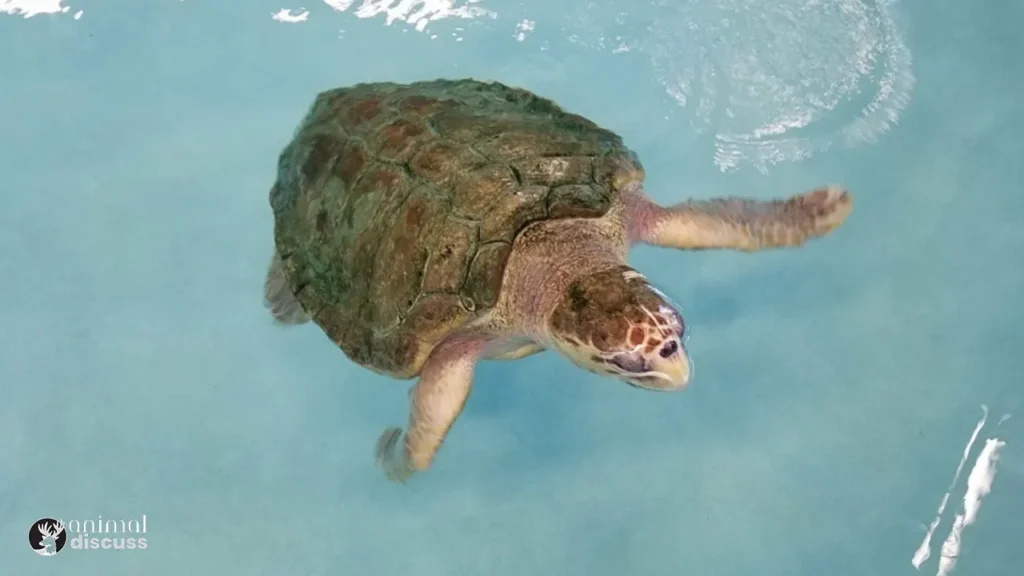
Join us until the behavioral wonders of the green sea turtles are revealed and ride on a journey to a newfound admiration for this remarkable inhabitant of the ocean depths.
A Short Overview of Different Behavioral Traits
It could be excellent to provide a brief about Green Sea Turtle’s behavioral facts before evaluating them in order to have a rapid knowledge of their way of life.
| Behavioral Traits | Key Facts |
|---|---|
| Growing Habits | 1. Rapid growth in the first few years 2. Reach sexual maturity around 20-30 years old 3. Can live up to 80 years or more |
| Feeding Habits | 1. Herbivorous diet, primarily feeding on seagrass 2. Opportunistic feeders, also consume algae 3. Use their strong jaws to bite and tear food |
| Breeding Habits & Migration Patterns | 1. Migrate long distances to nesting beaches 2. Females lay multiple clutches of eggs 3. Eggs incubate in sand for around 60 days 4. Seasonal migrations for feeding and breeding 5. Can travel thousands of kilometers |
| Ecological Adaptations | 1. Shell provides protection against predators 2. Camouflage coloration for blending into the environment 3. Able to withstand long periods without food or water |
| Aggression & Territorial Habits | 1. Display territorial behavior near nesting beaches 2. Can exhibit aggressive behavior during mating season 3. Engage in dominance displays and vocalizations |
| Social Dynamics | 1. Mostly solitary creatures except during mating 2. Nesting females may gather in groups 3. Juveniles and sub-adults may form social groups |
Curious about “Green Sea Turtle?” Check out this article to learn more!
Behavioral Diversity of Green Sea Turtles.
Green Sea turtles have learned skills that allow them to thrive in their native settings, much like other animals. We’ll go through a couple of the elements that influence Green Sea Turtle’s behavior in this section.
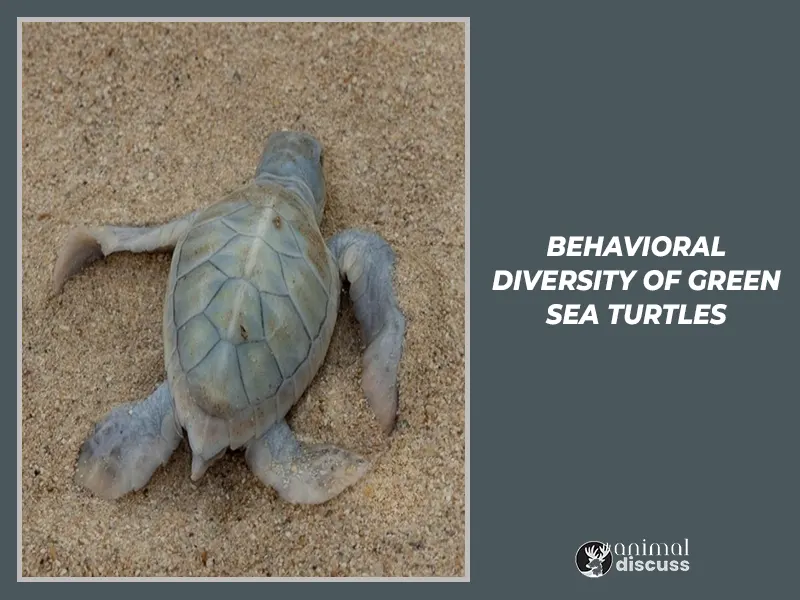
Their capacity to obtain food is evidence of their versatility; they graze on seagrass while foraging in seagrass beds, crushing the tough leaves with their powerful jaws.
Their ability to explore great distances, to hide themselves from predators with camouflage, and to modify their behavior to suit their environment is also remarkable.
Green sea turtles have exceptional abilities when it comes to reproduction. They have an incredible homing ability, consistently returning to the same beaches to lay their eggs. By participating in elaborate courtship rituals and aggressive mating practices, they guarantee the survival of their species.
Symbiotic partnerships with fish and cleaner creatures allow them to benefit from parasite elimination while also significantly contributing to biodiversity and ecological balance.
Growing Habits of Green Sea Turtles
It’s amazing how Green Sea Turtles’ growing habits impact their resistance and survival. From delicate hatchlings to beautiful adults, their oceanic adventure shows extraordinary flexibility and strength.
Join us as we discover Green Sea Turtles’ transforming phases, their growth secrets, and their amazing qualities that distinguish their submarine existence. Let’s explore the key stages of their growth:
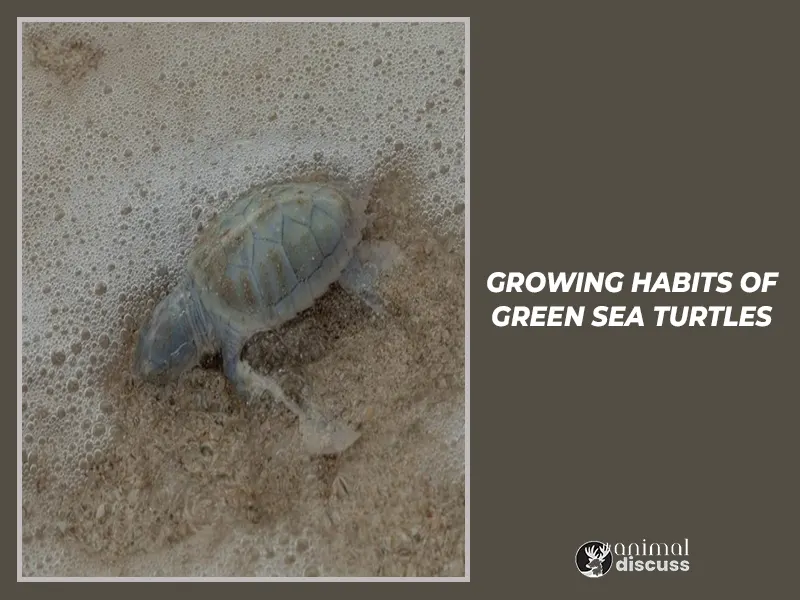
Growth in the 1st Year:
- Hatchlings emerge from their nests and make their way to the ocean.
- At this stage, they are small, measuring around 5-6 centimeters in length.
- They undergo rapid growth during their first year, with an average weight gain of 15-20 grams per day.
- Their streamlined shells and flippers allow them to navigate the water with agility.
Growth Between 1-5 Years:
- During this period, Green Sea Turtles experience significant growth and development.
- The average growth rate for Green Sea Turtles during this stage is approximately 3-4 centimeters in carapace length per year.
- By the age of 5, they can reach a carapace length of about 60-80 centimeters.
Growth between 5-8 Years:
- As Green Sea Turtles continue to mature, their growth rate gradually slows down.
- During this stage, they may gain an additional 5-10 centimeters in carapace length.
Adult Growth:
- Green Sea Turtles reach sexual maturity between the ages of 20-50, depending on various factors.
- At this stage, they have attained their full size and weight, with adult females typically being larger than males.
- Adult Green Sea Turtles can reach an impressive carapace length of up to 1.2 meters and weigh around 200-300 kilograms.
- Their slow growth rate in adulthood allows them to maintain their robust bodies and adapt to their marine environment.
Behavioral differences: Comparisons of Growth Habits Among Species
Green Sea Turtles are species with distinctive behavioral characteristics, including how they grow. Different Sea Turtle species display various growth patterns, as shown in the chart below:
| Species | Height (in) | Weight (lb) | Maximum Size | Lifespan (years) | Age of Sexual Maturity |
|---|---|---|---|---|---|
| Loggerhead Turtle | 29-37 | 200-400 | Up to 4 ft | 50-67 | 17-33 years 20-40 years 10-15 years 10-15 years |
| Hawksbill Turtle | 25-35 | 100-200 | Up to 3 ft | 30-50 | 20-40 years 10-15 years 10-15 years |
| Leatherback Turtle | 55-63 | 550-2000 | Up to 7 ft | 30-45 | 10-15 years |
| Kemp’s Ridley Turtle | 22-23 | 80-100 | Up to 2 ft | 30-50 | 10-15 years |
Feeding Habits
Do you know How do Green Sea Turtles adapt their feeding habits to ensure survival in their aquatic habitats? Observing Green Sea Turtle feeding habits reveals their underwater survival and adaptation. These amazing animals use accuracy and strategy to find food.
Let’s investigate Green Sea Turtles’ complex feeding patterns and how they help them survive in marine habitats.
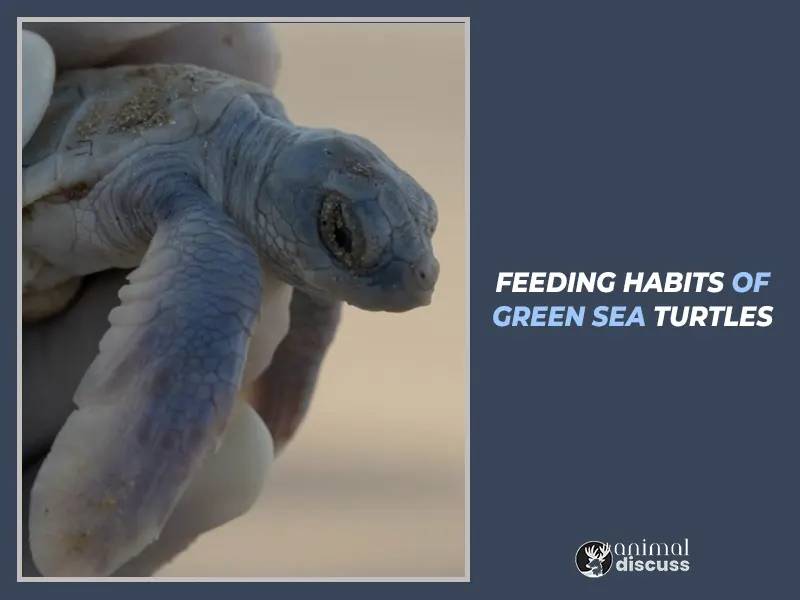
Feeding Habits of Adult Green Sea Turtles
Adult Green Sea Turtles have been seen to consume a diet that is predominately composed of plant matter, with seagrass, algae, and other marine plants serving as their primary sources of nourishment.
They are able to shred and bite off pieces of plants while they are submerged by making use of their powerful jaws that resemble beaks.
Their sophisticated digestive systems enable them to ingest and extract nutrients from plant material in an efficient manner, thereby ensuring that they digest food properly and absorb sufficient amounts of energy.
These turtles have a fascinating feeding pattern, spending extended hours grazing on seagrass meadows. They move smoothly through the water while engaging in this activity and satisfy their nutritional requirements by ingesting significant quantities of the flora around them.
Feeding Habits of Green Sea Turtle Cubs
Green Sea Turtle cubs, often known as hatchlings, consume food in such a way that is normally dissimilar to that of their adult turtles. These baby turtles go through a considerable transition in their diet as they age, gradually moving toward a predominantly herbivorous diet centered around seagrass and algae. This occurs as they mature into adulthood.
This developmental shift in feeding patterns demonstrates the Green Sea Turtle’s versatility and draws attention to the important function that seagrass and algae play in the general nutrition and growth of Green Sea Turtles throughout all phases of their lives.
It is crucial to be aware that the feeding behavior of this amazing creatures vary based on the variety of factors, including their age, place, and the availability of food in the surroundings in which they abide in.
Breeding & Mating Habits
Breeding and Mating habits are a crucial aspect of the Green Sea Turtles’ life cycle, shaping their population and ensuring their survival. These fascinating creatures exhibit distinct behaviors during the breeding season.
Let’s explore the key elements of their breeding and mating habits:
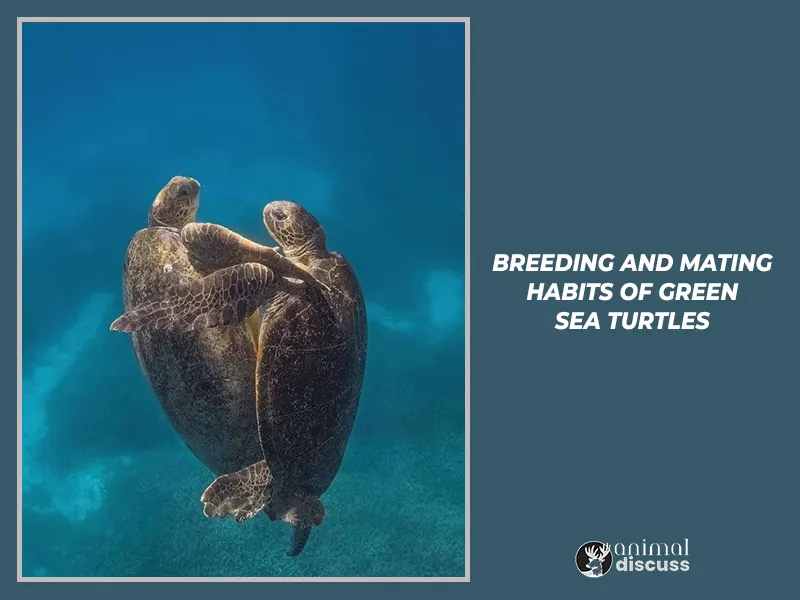
Mating Rituals:
Green sea turtles are ancient seafarers, and their complex mating and reproduction rituals are crucial to their continued existence. The Mating Period is distinguished by a magnificent exhibition of nature’s wonders because it is such a major occurrence.
At this time of year, male Green Sea Turtles use their strong flippers to court interested females. The males compete for dominance in their courtship dances by using delicate touches and graceful movements.
Most mating occurs in the calm seas surrounding the Mating Places, which are typically located close to the colonies’ nesting grounds. The turtle’s mate in these safe, shallow waters, ensuring the species’ survival. As a result of natural selection’s painstaking process, females are picky about who they mate with, and they tend to go for men who have distinct personalities.
Breeding Rituals
After a successful mating, the female Green Sea Turtles travel alone to a sandy beach for a suitable nesting site. The female excavates a hole in the warm sand to lay her eggs, which are then incubated there, during the breeding process.
The breeding season, which is carefully scheduled to correspond with local weather patterns, temperatures, and moon cycles, is essential to the nesting process’ success.
The female will carefully cover the nest to keep it hidden from any potential predators after the eggs have been placed. Green sea turtles show off an impressive mix of instinct, flexibility, and evolutionary brilliance in their complex mating and breeding rituals.
For the sake of the marine ecosystems they help sustain and the diversity they represent, it is essential that these behaviors be preserved across time.
Incubation and Hatching:
- The eggs are allowed to naturally incubate in the sandy warmth.
- The hatchlings’ sex is determined by the nest’s temperature.
- The hatchlings emerge from the nest and naturally migrate toward the ocean after a few weeks of incubation.
Migration Patterns
Green Sea Turtles exhibit fascinating migration patterns that contribute to their survival and ecological balance. These patterns involve remarkable journeys and behaviors that highlight the adaptability and resilience of these magnificent creatures.
Here are the key aspects of Green Sea Turtles’ migration:
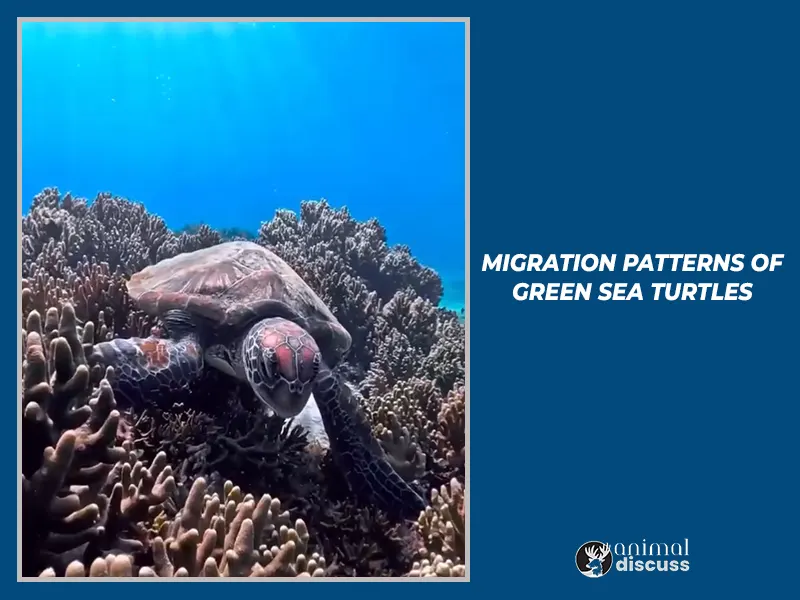
Foraging Migration:
Green Sea Turtles travel enormous oceans in quest of ample food. These turtles travel long distances to find seagrass beds, using ocean currents and their natural navigation skills. Their life depends on these movements to reach seagrass meadows’ abundant vegetation.
Breeding Migration:
Female Green Sea Turtles travel great distances to breed on their native beaches. These turtles navigate precisely using their intuition and Earth’s magnetic fields. Returning to the beaches where they were born helps preserve their species.
Intergenerational Migration:
Green Sea Turtle hatchlings migrate from their nesting beach. These tiny invertebrates use ocean currents to go to their feeding grounds in the vast ocean. This early migration shows their exceptional navigational skills and adaptability across the vast maritime expanse.
Ecological Adaptations
The Green Sea Turtle has evolved remarkable ecological adaptations that allow it to flourish in its marine habitats. These adaptations have substantially influenced their behavior and physiology.
Here are some notable ecological adaptations of Green Sea Turtles:
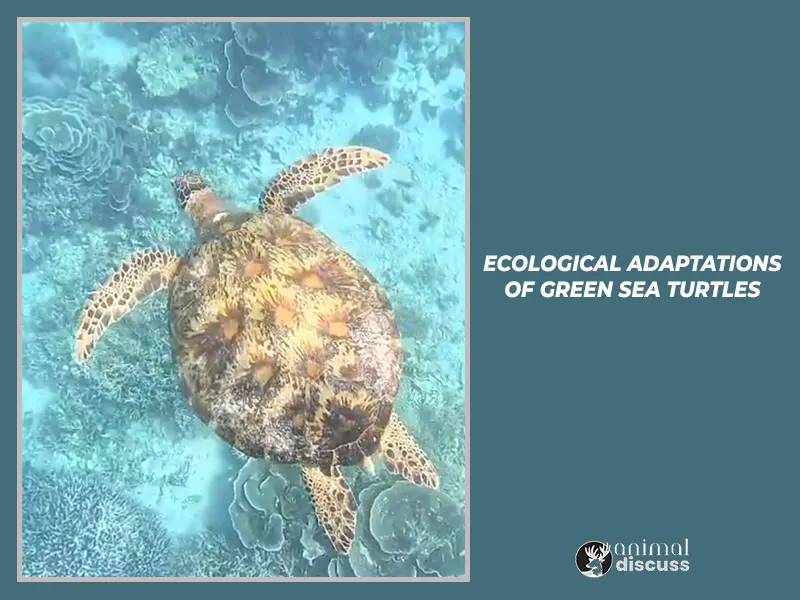
Shell Design:
A Green Sea Turtle’s carapace, or shell, is essential to its aquatic lifestyle. This structure lets them swim easily, demonstrating their swimming skills. The shell protects them from predators and other risks in addition to improving locomotion.
Salt Gland:
Green Sea Turtles have unusual salt glands near their eyes. These glands let turtles remove excess salt, which is necessary since they drink seawater. This specialized mechanism keeps them balanced and prevents dehydration, ensuring their survival in the harsh sea environment.
Thermal Regulation:
Ectothermic Green Sea Turtles regulate their body temperature with their surroundings. They do this by getting hot in the sun or cooling off in water. This optimizes metabolism, conserving energy and allowing them to adjust to different water temperatures.
Aggression And Territorial Habits
Aggression and territorial behaviors in Green Sea Turtles are fascinating aspects of their behavior. Here are some key points about their aggression and territorial habits:
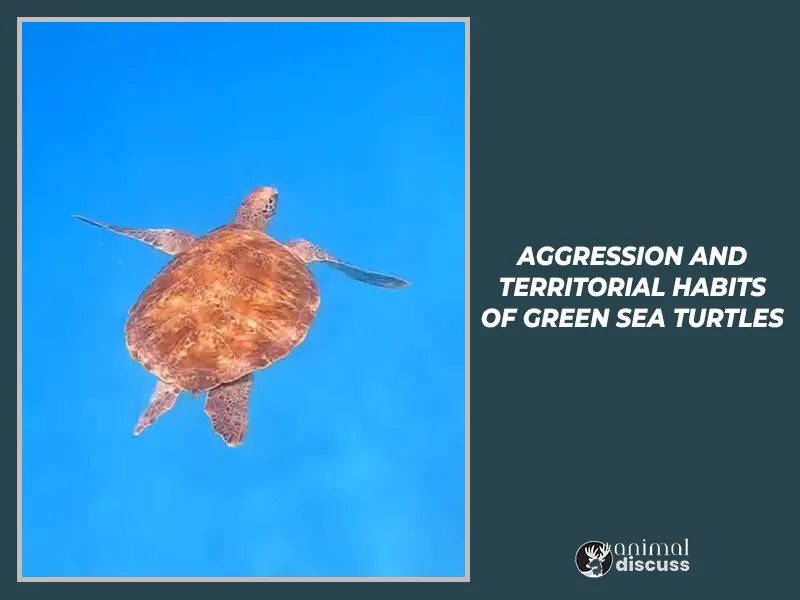
Aggression:
During the breeding season, male Green Sea Turtles engage in vicious battles with one another, head-butting and even flipping their adversaries over. Fights like these are necessary to establish dominance in order to mate with females. The beach nesting grounds of male Green Sea Turtles are vigilantly guarded, which is an essential behavior for the reproduction of the species.
Territoriality:
The Green Sea Turtle is an endangered species that uses smell markings and pheromones to establish its territory. These are land-based and aquatic markers. Their areas for mating, feeding, and nesting are fiercely guarded.
Females select certain locations within their territories in which to deposit their eggs and strongly guard these nesting sites, which frequently results in hostile confrontations and intense struggle for resources and mates within territorial conflicts.
Social Behavior
Do you know what drives the intricate social behavior of Green Sea Turtles beneath the ocean’s surface? They exhibit various social behaviors that contribute to their survival and overall well-being.
Let’s delve into some key aspects of their social behavior:
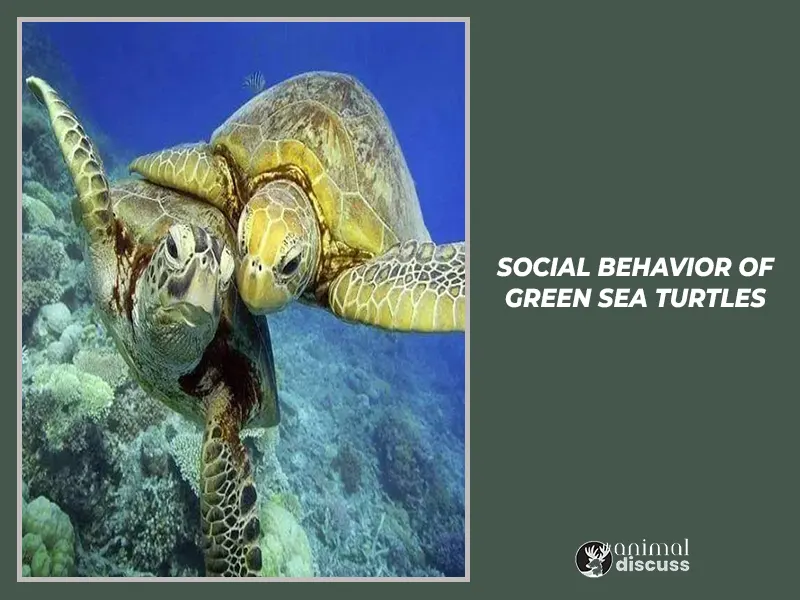
- 01. Communication: Turtles use various forms of communication to interact with one another. This includes body language, such as head movements and flipper gestures, as well as vocalizations such as hissing or grunting sounds.
- 02. Cooperative Behavior: Green Sea Turtles may display cooperative behavior, especially during nesting. Females sometimes nest in groups, known as arribadas, where they synchronize their nesting activities. This behavior offers protection against predators and enhances their chances of successful nesting.
- 03. Social Hierarchies: Within aggregations, Green Sea Turtles may establish social hierarchies. Dominant individuals have access to better feeding grounds or prime nesting sites, while subordinate turtles may have to settle for less favorable locations.
- 04. Mutual Benefits: Social interactions among Green Sea Turtles can provide mutual benefits. For example, turtles may engage in “cleaning stations” where certain fish species remove parasites from the turtles’ shells, benefiting both parties involved
- 05. Social Learning: Green Sea Turtles can exhibit social learning, where individuals observe and learn from the behaviors of others. This can include finding optimal foraging sites, avoiding predators, and adopting successful nesting strategies.
Factors that Influence Different Behavioral Traits
Have you ever wondered why certain species of Green Sea Turtles are more hostile than others? Or why do particular Green Sea Turtles behave differently from other turtles regarding their social interactions? These behavioral variations are impacted by several variables, including:
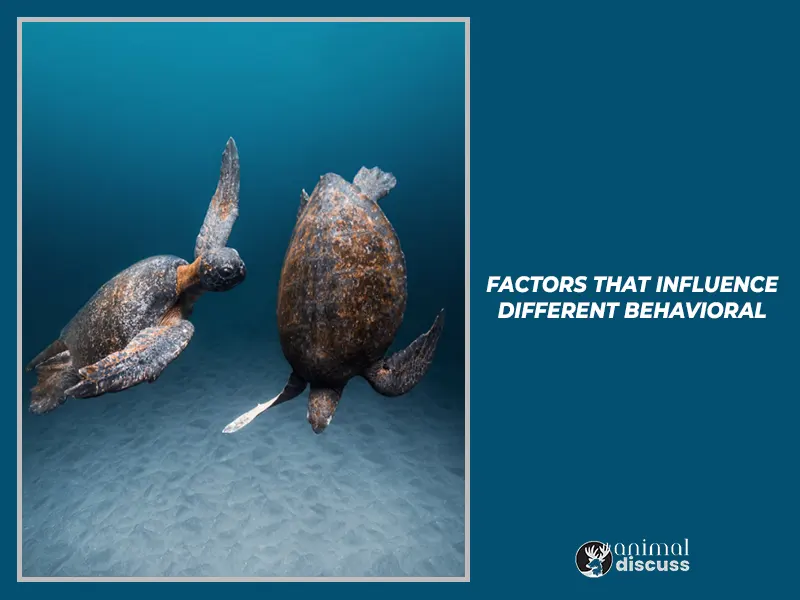
Environmental Factors:
- Temperature: The temperature of the nesting beach plays a significant role in determining the sex of the hatchlings. Warmer temperatures produce more females, while cooler temperatures result in more males.
- Food Availability: The abundance and distribution of food sources influence the foraging behavior and movement patterns of Green Sea Turtles.
Genetic Factors:
- Genetic Variation: Genetic differences among individuals can contribute to variations in behavior, such as nesting site preferences, migratory patterns, or feeding habits.
- Inherited Traits: Certain behavioral traits may be inherited, passed down from one generation to another. These traits can affect aspects like nesting behaviors or the ability to navigate during migrations.
Social Interactions:
- Learning from Others: Green Sea Turtles can acquire behavioral traits through social learning, observing and imitating the behaviors of other individuals in their group.
- Dominance Hierarchy: Within a group of Green Sea Turtles, hierarchical structures may form, with dominant individuals influencing the behavior of subordinate individuals.
Human-Induced Factors That Change Green Sea Turtles Behavior
Have you considered how people, even unintentionally, affect animal behavior? Unfortunately, humans damage the environment, ruin habitats, and change the climate, which can affect Green Sea Turtles and other creatures. Some examples:
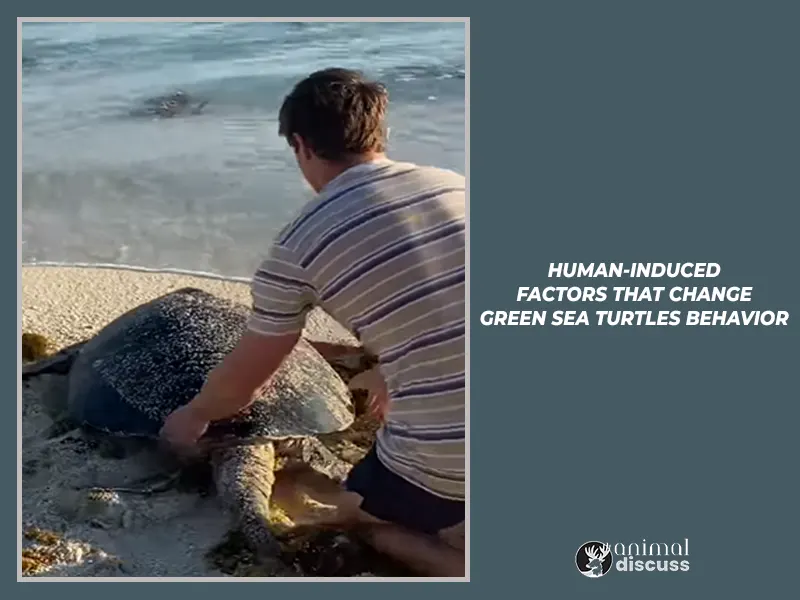
Habitat Destruction and Fragmentation: As coastal constructions and activities destroy nesting places and seagrass beds, habitat destruction and fragmentation are major issues.
Pollution and Contamination: Toxins from ocean pollution and contamination enter turtle habitats, impacting their health and behavior. Plastic waste and chemical pollutants pollute their food, harming them.
Climate Change: Climate change, another major threat, raises sea temperatures and changes ocean currents, affecting prey and breeding grounds. Turtles must quickly adjust to new, often unsuitable surroundings due to these alterations.
Overfishing and Bycatch: Human overfishing and bycatch diminish turtle food sources and cause inadvertent capture. This affects their existence and changes their behavior, forcing them to look for food elsewhere, harming their habitats.
Tourism and Human Interaction: Human interaction and tourism complicate matters. Responsible eco-tourism raises awareness, but disturbing nesting places or feeding them odd food can modify their behavior.
How to Conserve Green Sea Turtles’ Behavior
In recent years, the charming behavior of Green Sea Turtles has been a significant concern for wildlife conservationists.
As a result of the decline in the population of Green Sea Turtles caused by habitat loss, poaching, and climate change, numerous organizations and institutions have been granted permission to adopt conservation measures.
Numerous organizations actively advocate the preservation of these magnificent creatures and their behavior. These organizations include:
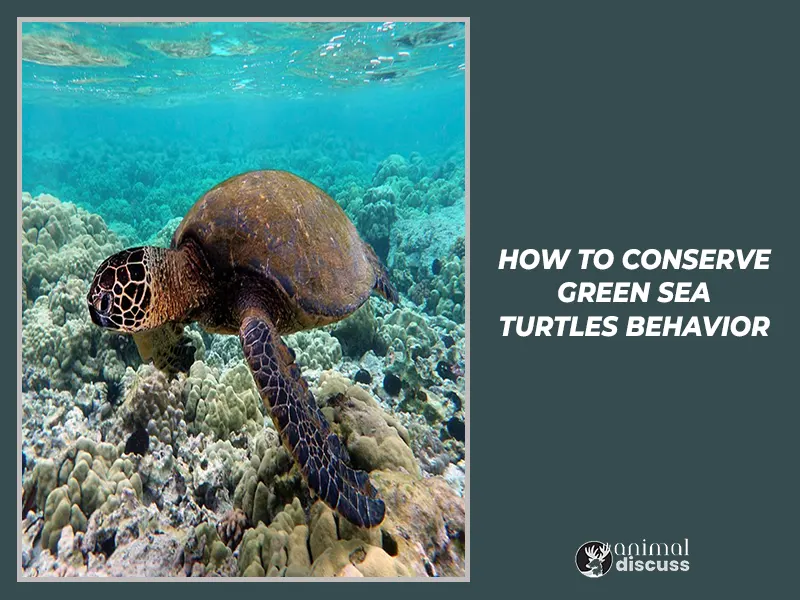
Sea Turtle Conservancy (STC): The Sea Turtle Conservancy (STC) is one of the prime research and conservation institution for protecting the sea turtles in the marine world. They primarily look at conserving the nesting sites for the sea turtles, carrying out research, supporting for safeguarding techniques, and increasing awareness about the sea turtle conservation.
Archie Carr Center for Sea Turtle Research (ACCSTR): The ACCSTR operates at the University of Florida and focuses on sea turtle research, conservation, and education, including the green sea turtle.
The ACCSTR significantly contributes in monitoring and maintaining the populations of green sea turtles, implementing conservation strategies, and educating the general public about the importance of sea turtle conservation.
They plays a vital role to the long-term existence and sustainability of the green sea turtles and their habitual facts through conducting research and conservation attempts.
The Marine Megafauna Foundation (MMF): The Marine Megafauna Foundation focus on the sea turtle conservation as a part of its broader efforts to preserve marine animals, in spite of not focusing only on the green sea turtles.
They carry out research and protecting initiatives in the globe, such as in the Maldives, Mexico, and Mozambique where green sea turtles are found. The vision of the foundation is to comprehend the behavior and ecology of sea turtles, to identify the overall challenges they have to face, and to implement conservation tactics.
Some possible steps that can be considered to protect Green Sea Turtles:
For the long-term existence of Green Sea Turtles and the bio-diversity of the marine ecosystems, it is crucial to safeguard their natural behavior.
Preserving their habitats, reducing human-caused challenges, and spreading responsible behavior are the main focus of conservation efforts designed to protect their behavior. Here are some key aspects of conserving the behavior of Green Sea Turtles:
- Protected Areas and Habitat Preservation: To protect Green Sea Turtle breeding, feeding, and migrating habitats, sanctuaries are needed. Regulations and policies that safeguard nesting areas and feeding grounds allow turtles to use them naturally and thrive.
- Sustainable Fishing Practices: Sustainable fishing methods like selective gears reduce sea turtle bycatch, conserving foraging. Encourage Turtle Excluder Devices (TEDs) in nets to protect marine life from entanglement.
- Pollution Control and Waste Management: Selective fishing techniques maintain sea turtle foraging while lowering bycatch. Encourage the use of Turtle Excluder Devices (TEDs) to prevent entanglement of marine species.
- Education and Awareness: Encourage education and community involvement to preserve Green Sea Turtles’ natural behaviors. Encourage turtle behavior appreciation and learning through ethical ecotourism with minimal disturbance.
Conclusion
In conclusion, the behavioral miracles of green sea turtles captivate our imagination and remind us of the astounding natural world’s wonders. We must concede the vitality of their behavior and take some proactive steps to protect their habitats and ensure their long-term sustainability.
By implementing sustainable tactics, reducing pollution, and supporting the conservation efforts of the organizations, we can contribute in protecting the population of green sea turtles. These efforts not only preserve the species but also ensure the health and balance of our oceans and the intricate ecosystems they harbor.
Let us embark on a journey of shared responsibility, where each individual becomes a guardian of these remarkable creatures. Together, we can ensure that future generations witness the majesty of green sea turtles and experience the profound connection we have with the natural world.
Reference
- https://en.wikipedia.org/wiki/Green_sea_turtle
- https://www.fisheries.noaa.gov/species/green-turtle
- https://www.worldwildlife.org/species/green-turtle
- https://kids.nationalgeographic.com/animals/reptiles/facts/green-sea-turtle
- https://www.nationalgeographic.com/animals/reptiles/facts/green-sea-turtle
- https://www.thainationalparks.com/species/green-sea-turtle
- https://www.fws.gov/species/green-sea-turtle-chelonia-mydas
- https://www.biologicaldiversity.org/campaigns/esa_works/profile_pages/PacificGreenSeaTurtle.html
Image Credits
- Twitter.com/HIEXPensacola
- Twitter.com/savethe25146703
- Twitter.com/tortoise_loveer
- Twitter.com/seaturtleweek
- Twitter.com/CentuoWorld
- Twitter.com/tortoise_loveer
- Twitter.com/savegalapagos
- youtube.com/shorts/ZiwkNZd7muM

